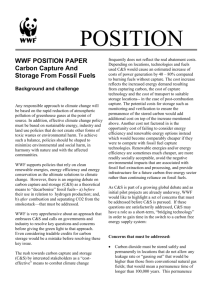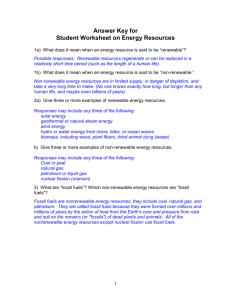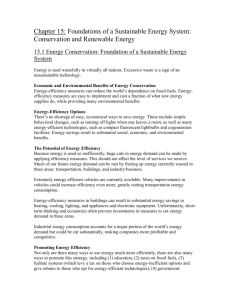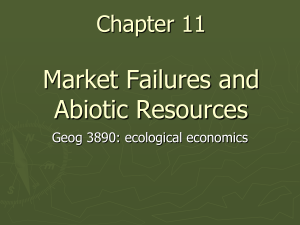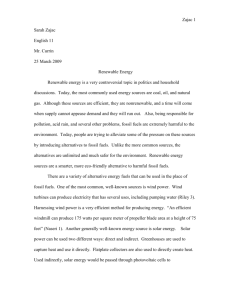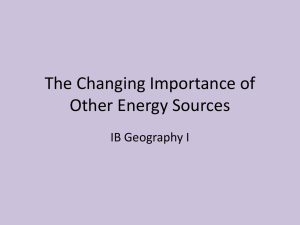Physical Science
advertisement
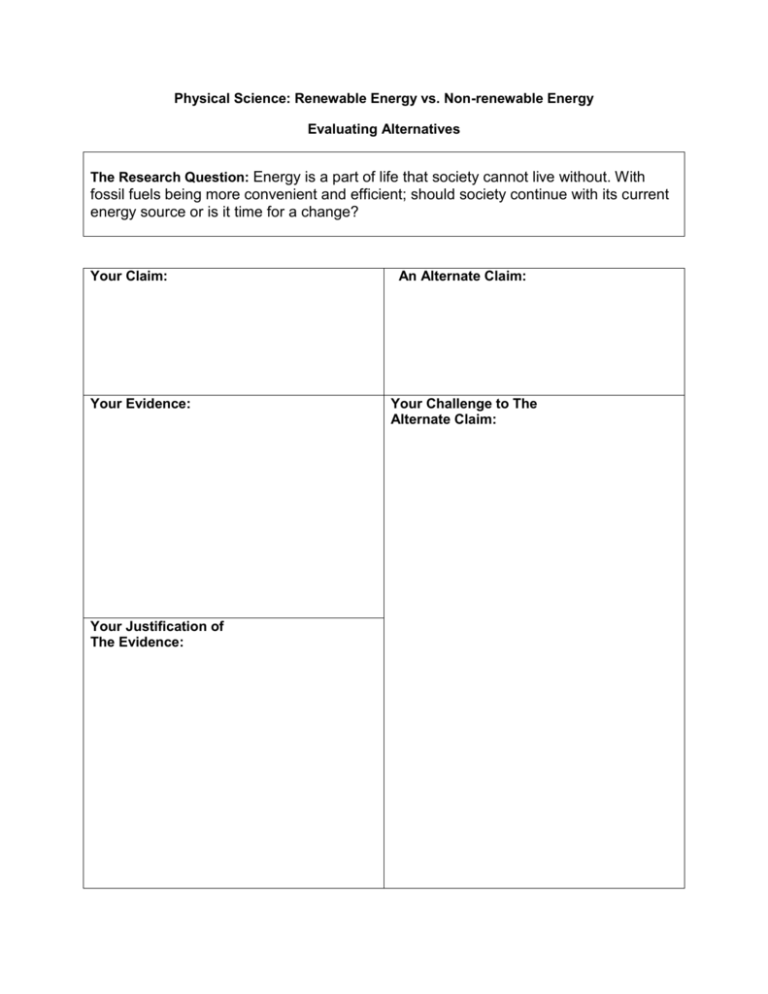
Physical Science: Renewable Energy vs. Non-renewable Energy Evaluating Alternatives The Research Question: Energy is a part of life that society cannot live without. With fossil fuels being more convenient and efficient; should society continue with its current energy source or is it time for a change? Your Claim: Your Evidence: Your Justification of The Evidence: An Alternate Claim: Your Challenge to The Alternate Claim: Fossil Fuels: Their Advantages and Disadvantages Man’s fuel needs, since the olden times, have been met through the use of fossil fuels. Fossil fuels, as its name suggests, were formed from the organic remains of prehistoric plants and animals. They are responsible for much of the world’s electric power and total energy demands. Since 1900, the world’s consumption of fossil fuels has nearly doubled every 20 years. Fossil fuels comprise mainly of coal, oil and gas. These three were formed millions of years ago beneath the earth’s surface from the decomposed bodies of dead plants and animals. They are foreseen to be in short supply in the future as man?s fuel needs continue to grow at a fast rate. Crude oil is also referred to as petroleum. Compared to coal, this is easier to extract from the ground through the use of pipes thereby making it less costly to transport from one place to another. Natural gas has other uses apart from being burned in power plants to generate electricity. Many people also use it in their home heating systems to provide warm air during the cold winter season. Advantages of Fossil Fuels ls is their capacity to generate huge amounts of Transporting oil and gas to the power stations can be made through the use of pipes stations that make use of fossil fuel can be constructed in almost any location. This is possible as long as large quantities of fuel can be easily brought to the power plants. Disadvantages of Fossil Fuels dioxide when burned thereby causing a greenhouse effect. This is also the main produces carbon dioxide when burned compared to burning oil or gas. Additionally, it ironmentally, the mining of coal results in the destruction of wide areas of land. Mining this fossil fuel is also difficult and may endanger the lives of miners. Coal mining is considered one of the utilize coal need large amounts of fuel. In other words, they not only need truckloads but trainloads of coal on a regular basis to continue operating and generating electricity. This only means that coal-fired power plants should have reserves of coal in a large area near the plant’ Use of natural gas can cause unpleasant odors and some problems especially with such as oil spills when oil tankers, for instance, experience leaks or drown deep under the sea. Crude oil contains toxic chemicals which cause air pollutants when combusted. The Advantages and Disadvantages of Renewable Energy One major advantage with the use of renewable energy is that as it is renewable it is therefore sustainable and so will never run out. Renewable energy facilities generally require less maintenance than traditional generators. Their fuel being derived from natural and available resources reduces the costs of operation. Even more importantly, renewable energy produces little or no waste products such as carbon dioxide or other chemical pollutants, so has minimal impact on the environment. Renewable energy projects can also bring economic benefits to many regional areas, as most projects are located away from large urban centres and suburbs of the capital cities. These economic benefits may be from the increased use of local services as well as tourism. The Disadvantages of Renewable Energy It is easy to recognise the environmental advantages of utilising the alternative and renewable forms of energy but we must also be aware of the disadvantages. One disadvantage with renewable energy is that it is difficult to generate the quantities of electricity that are as large as those produced by traditional fossil fuel generators. This may mean that we need to reduce the amount of energy we use or simply build more energy facilities. It also indicates that the best solution to our energy problems may be to have a balance of many different power sources. Another disadvantage of renewable energy sources is the reliability of supply. Renewable energy often relies on the weather for its source of power. Hydro generators need rain to fill dams to supply flowing water. Wind turbines need wind to turn the blades, and solar collectors need clear skies and sunshine to collect heat and make electricity. When these resources are unavailable so is the capacity to make energy from them. This can be unpredictable and inconsistent. The current cost of renewable energy technology is also far in excess of traditional fossil fuel generation. This is because it is a new technology and as such has extremely large capital cost. 1 ream of paper = 6% of a tree and 5.4kg CO2 in the atmosphere. http://www.solarschools.net/resources/stuff/advantages_and_disadvantages.aspx The Washington Post A challenge to everything you think you know By Robert Bryce Sunday, April 25, 2010 Americans are being inundated with claims about renewable and alternative energy. Advocates for these technologies say that if we jettison fossil fuels, we'll breathe easier, stop global warming and revolutionize our economy. Yes, "green" energy has great emotional and political appeal. But before we wrap all our hopes -- and subsidies -- in it, let's take a hard look at some common misconceptions about what "green" means. THIS STORY 5 Myths about green energy Sparking an energy revolution 1. Solar and wind power are the greenest of them all. Unfortunately, solar and wind technologies require huge amounts of land to deliver relatively small amounts of energy, disrupting natural habitats. Even an aging natural gas well producing 60,000 cubic feet per day generates more than 20 times the watts per square meter of a wind turbine. A nuclear power plant cranks out about 56 watts per square meter, eight times as much as is derived from solar photovoltaic installations. The real estate that wind and solar energy demand led the Nature Conservancy to issue a report last year critical of "energy sprawl," including tens of thousands of miles of high-voltage transmission lines needed to carry electricity from wind and solar installations to distant cities. Nor does wind energy substantially reduce CO2 emissions. Since the wind doesn't always blow, utilities must use gas- or coal-fired generators to offset wind's unreliability. The result is minimal -- or no -- carbon dioxide reduction. Denmark, the poster child for wind energy boosters, more than doubled its production of wind energy between 1999 and 2007. Yet data from Energinet.dk, the operator of Denmark's natural gas and electricity grids, show that carbon dioxide emissions from electricity generation in 2007 were at about the same level as they were back in 1990, before the country began its frenzied construction of turbines. Denmark has done a good job of keeping its overall carbon dioxide emissions flat, but that is in large part because of near-zero population growth and exorbitant energy taxes, not wind energy. And through 2017, the Danes foresee no decrease in carbon dioxide emissions from electricity generation. 2. Going green will reduce our dependence on imports from unsavory regimes. In the new green economy, batteries are not included. Neither are many of the "rare earth" elements that are essential ingredients in most alternative energy technologies. Instead of relying on the diversity of the global oil market -- about 20 countries each produce at least 1 million barrels of crude per day -- the United States will be increasingly reliant on just one supplier, China, for elements known as lanthanides. Lanthanum, neodymium, dysprosium and other rare earth elements are used in products from high-capacity batteries and hybrid-electric vehicles to wind turbines and oil refinery catalysts. China controls between 95 and 100 percent of the global market in these elements. And the Chinese government is reducing its exports of lanthanides to ensure an adequate supply for its domestic manufacturers. Politicians love to demonize oil-exporting countries such as Saudi Arabia and Iran, but adopting the technologies needed to drastically cut U.S. oil consumption will dramatically increase America's dependence on China. 3. A green American economy will create green American jobs. In a global market, American wind turbine manufacturers face the same problem as American shoe manufacturers: high domestic labor costs. If U.S. companies want to make turbines, they will have to compete with China, which not only controls the market for neodymium, a critical ingredient in turbine magnets, but has access to very cheap employees. The Chinese have also signaled their willingness to lose money on solar panels in order to gain market share. China's share of the world's solar module business has grown from about 7 percent in 2005 to about 25 percent in 2009. Meanwhile, the very concept of a green job is not well defined. Is a job still green if it's created not by the market, but by subsidy or mandate? Consider the claims being made by the subsidydependent corn ethanol industry. Growth Energy, an industry lobby group, says increasing the percentage of ethanol blended into the U.S. gasoline supply would create 136,000 jobs. But an analysis by the Environmental Working Group found that no more than 27,000 jobs would be created, and each one could cost taxpayers as much as $446,000 per year. Sure, the government can create more green jobs. But at what cost? 4. Electric cars will substantially reduce demand for oil. Nissan and Tesla are just two of the manufacturers that are increasing production of all-electric cars. But in the electric car's century-long history, failure tailgates failure. In 1911, the New York Times declared that the electric car "has long been recognized as the ideal" because it "is cleaner and quieter" and "much more economical" than its gasoline-fueled cousins. But the same unreliability of electric car batteries that flummoxed Thomas Edison persists today. Those who believe that Detroit unplugged the electric car are mistaken. Electric cars haven't been sidelined by a cabal to sell internal combustion engines or a lack of political will, but by physics and math. Gasoline contains about 80 times as much energy, by weight, as the best lithium-ion battery. Sure, the electric motor is more efficient than the internal combustion engine, but can we depend on batteries that are notoriously finicky, short-lived and take hours to recharge? Speaking of recharging, last June, the Government Accountability Office reported that about 40 percent of consumers do not have access to an outlet near their vehicle at home. The electric car is the next big thing -- and it always will be. 5. The United States lags behind other rich countries in going green. Over the past three decades, the United States has improved its energy efficiency as much as or more than other developed countries. According to data from the Energy Information Administration, average per capita energy consumption in the United States fell by 2.5 percent from 1980 through 2006. That reduction was greater than in any other developed country except Switzerland and Denmark, and the United States achieved it without participating in the Kyoto Protocol or creating an emissions trading system like the one employed in Europe. EIA data also show that the United States has been among the best at reducing the amount of carbon dioxide emitted per $1 of GDP and the amount of energy consumed per $1 of GDP. America's move toward a more service-based economy that is less dependent on heavy industry and manufacturing is driving this improvement. In addition, the proliferation of computer chips in everything from automobiles to programmable thermostats is wringing more useful work out of each unit of energy consumed. The United States will continue going green by simply allowing engineers and entrepreneurs to do what they do best: make products that are faster, cheaper and more efficient than the ones they made the year before. Robert Bryce is a senior fellow at the Manhattan Institute. His fourth book, "Power Hungry: The Myths of 'Green' Energy and the Real Fuels of the Future," will be out Tuesday, April 27. Want to challenge everything you think you know? Visit the "Five Myths" archive. http://www.washingtonpost.com/wp-dyn/content/article/2010/04/23/AR2010042302220.html



